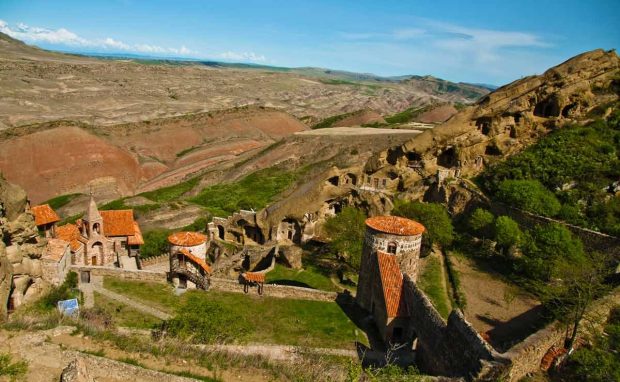[해외여행] 조지아 동부 ‘다비트가레자 동굴수도원’ 순례자를 만나다

[아시아엔=카투나 차피차드제 조지아공대 교수] 아제르바이잔과 국경지대에 위치한 다비트 가레자 수도원은 경이로움 그 자체다. 사막같이 광활하게 펼쳐지는 풍경과 초여름 들판의 꽃들은 수도원의 고즈넉함을 더욱 빛내준다.
다비트 가레자는 오랫동안 버려진 드넓은 지역에 흩어져 있는 수도원 15곳을 총칭하는 이름이다. 이 가운데 구소련에 의해 재건돼 지금은 수도사들이 기거하고 있는 라브라(Lavra) 수도원과, 그 위 언덕에 자리잡은 우다브노(Udabno) 수도원 두곳이 특히 유명하다. 이 두곳을 주로 관광객들이 찾는데 우다브노 수도원에는 프레스코화가 자랑거리다.
라브라 수도원은 6세기 경 조지아에 기독교를 전파하기 위해 중동에서 온 금욕주의 신부 13명 중 1인인 다비트 가레자가 세웠다. 주변의 광활한 지역에 다른 수도원들이 들어서면서 라브라 수도원도 동시에 커졌다. 이곳에서 중세 이후 교회문서들이 번역·복사됐다. 프레스코 화풍이 번성한 곳도 바로 이곳이다. 수도원은 1265년 몽골제국에 의해 파괴되었으나 14세기 조지 5세에 의해 재건되었다. 하지만 이후에도 몽골의 약탈이 계속돼 1615년 부활절에는 샤 얍바스 군대에 의해 수도사 6000명이 살해되고 예술품이 파괴되는 수난을 당했다.
수도원은 19세기말까지 문은 열어놓은 상태였지만 유명무실한 존재였다. 1921년 볼셰비키 정권은 아프가니스탄과의 전쟁에 대비해 이곳을 군사훈련 장소로 사용했다. 이로 인해 수도원 내부 벽화들이 상당히 훼손됐다. 조지아는 독립 후에야 수도원 원상 회복에 나서 현재의 모습을 갖추게 됐다.
이후 수도원은 순례자와 관광객이 즐겨찾으며 힐링여행의 명소로 탈바꿈했다. 수도원이 과거의 종교활동 중심지의 명성을 되찾은 것은 물론이다. 동굴 내부에는 오랜 동안파괴와 재건을 반복하며 간직해온 화려한 문양의 벽화들이 가득차 있다.
소련이 한때 위성국이던 국가들의 국경을 정하면서 문화와 종교적인 고려는 하지 않은 까닭에 현재 수도원 일부는 아제르바이잔에 위치해 있다. 조지아와 아제르바이잔 사이의 국경분쟁의 한 원인이 되기도 했다.
조지아는 다비트 가레자의 종교·문화의 중요성을 고려해 수도원이 두 나라로 분산돼 있는 것은 바람직하지 않다며 영토 교환을 제안해놓은 상태다.
Introducing Davit Gareja Cave Monastery, Eastern Georgia
On the border with Azerbaijan, the ancient monastery complex of Davit Gareja (or Gareji) is one of the most remarkable of Georgia’s historic sites. Its uniqueness is heightened by a lunar, semidesert landscape that turns green and blooms with flowers in early summer. Davit Gareja comprises about 15 monasteries spread over a remote area (most long abandoned), but visitors usually just see two ? Lavra (which has been restored since Soviet times and is now again inhabited by monks) and, on the hill above it, Udabno, which has beautiful frescoes.
Lavra, the original monastery here, was founded by Davit Gareja, one of the 13 ascetic Syrian fathers who returned from the Middle East to spread Christianity in Georgia in the 6th century. The complex grew until monasteries were spread over a wide area. Manuscripts were translated and copied, and a celebrated school of fresco painting flourished here. The monasteries were destroyed by the Mongols in 1265, revived in the 14th century by Giorgi V the Brilliant, sacked by Timur, and then destroyed on Easter night 1615 when Shah Abbas’ soldiers killed 6000 monks and trashed many of the artistic treasures. The monasteries never regained their former importance, though they remained active until the end of the 19th century.
It wasn’t until the Bolshevik takeover in 1921 that the monastery was closed down and became deserted. During the late Soviet years the monastery became a training ground for the Soviet War in Afghanistan and this caused considerable damage to the murals within the complex and caused a public outcry among Georgians. When Georgia restored its independence, the monastery was revived and it is once again a center of religious activity as well as an important destination for pilgrims and tourists alike. The inside of the cave structures has been covered with numerous artistic and colourful murals, a number of which have survived the test of time.
Since the Soviet border-drawing process did not have any regard for cultural borders, especially when religious heritage was involved, today parts of the monastery complex are technically located within Azerbaijan and this has sparked a minor border dispute between the two countries. Given the religious and cultural importance of Davit Gareja, Georgians have stated it to be unacceptable that the site would be split between two countries, and have offered a land swap, but a final agreement has yet to be achieved.
It takes two to three hours to explore Lavra and Udabno. In July and August it can get fearfully hot here by the middle of the day, so an early start, getting here by 10am, is ideal.
Prepared by Khatuna Chapichadze, Ph.D. in Social Sciences (Political Science), Associate Professor, Department of Liberal Arts, Faculty of Engineering Economics, Media Technologies and Social Sciences, Georgian Technical University





